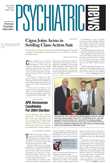Buprenorphine combined with naloxone (Suboxone) and buprenorphine alone (Subutex) are both safe and effective at reducing opiate use and craving when administered in an office-based setting.
A new report from the Buprenorphine/Naloxone Collaborative Study Group, led by researchers at the National Institute on Drug Abuse (NIDA), is the largest treatment trial of its kind. Funded by NIDA, which developed buprenorphine in collaboration with Reckitt-Benckiser Pharmaceuticals, the double-blind, placebo-controlled clinical trial involved 326 opiate-addicted patients at eight U.S. sites. The study was reported in the September 4 New England Journal of Medicine.
Patients taking combined buprenorphine and naloxone were three times more likely than patients taking placebo to screen negative for opiate use, and those taking buprenorphine alone were 3.6 times more likely to screen negative for opiate use. The results were so positive that the trial was terminated early because the institutional review board that approved the study no longer deemed it ethical to treat participants with placebo.
After four weeks of double-blind study, all patients were offered the opportunity to continue in an open-label phase for an additional 48 weeks with either buprenorphine alone or the combination. The trial, conducted in from late 1996 through 1997, became a pivotal study in the Food and Drug Administration’s approval of buprenorphine for office-based treatment of opiate addiction.
“Buprenorphine represents a major step forward in the treatment of opiate addiction,” said Nora Volkow, M.D., director of NIDA, in announcing the study’s publication. “It allows physicians to treat patients for this disease in the same manner that other people are treated for such other chronic illnesses as diabetes or high blood pressure.
“Office-based buprenorphine increases the availability of therapy by offering patients greater flexibility in treatment scheduling and integration with the mainstream public for their health services.”
Buprenorphine, chemically related to morphine, is a μ-opiate receptor agonist and a κ-opiate receptor antagonist that has been used in intravenous form in many countries (including the United States) for decades to treat moderate to severe pain. NIDA’s decade-long development of the medication into a sublingual formulation allows the drug to be absorbed into the bloodstream without having to go through the liver’s first-pass metabolism. While the drug has a potential for abuse—much like methadone and the soon-to-be-discontinued levomethadyl acetate (see
page 36)—combining buprenorphine with naloxone significantly reduces this potential.
Naloxone is thought to block the effects of opiates by competing directly for binding with the same receptors. This limits the effects of the opiate, including buprenorphine.
Office-based treatment with buprenorphine was authorized by the Drug Treatment Act of 2000, which allows Schedule III, IV, and V narcotics that are approved for addiction treatment to be administered for either medically supervised tapering (detoxification) or long-term maintenance therapy. On October 8, 2002, the FDA approved buprenorphine alone and in combination with naloxone (both Schedule III medications) for that use.
Physicians who wish to prescribe buprenorphine must take an eight-hour training course (APA provides an online training course on its Web site) and apply to the Substance Abuse and Mental Health Services Administration (SAMHSA) to be certified.
In an editorial accompanying the study, H. Westley Clark, M.D., J.D., M.P.H., director of SAMHSA’s Center for Substance Abuse Treatment, noted that “as of July 11, 2003, [SAMHSA] had received only 1,981 [applications for certification]. Many more physicians need to provide office-based treatment if the promise offered by the availability of buprenorphine is to be achieved.”
An abstract of the study is posted on the Web at http://content.nejm.org/cgi/content/abstract/349/10/949. More information on buprenorphine training through APA is posted at www.psych.org by logging into the online CME section where APA member number and password are required. ▪
NEJM 2003 349 949

